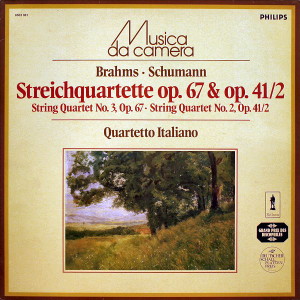 |
|
Philips
- 1 LP - 6503 061
|
|
QUARTETTO ITALIANO
- Paolo Borciani, Elisa Pegreffi, violino
- Piero Farulli,
viola
- Franco Rossi, violoncello |
|
|
|
|
|
Luogo e data
di registrazione |
|
La
Salle des
Remparts, La
Tour-de-Peilz
(Svizzera):
- 15-27 giugno
1971 (Schumann)
-
15-27 gennaio
1971 (Brahms)
|
|
|
Registrazione: live
/ studio |
|
studio |
|
|
Producer / Engineer |
|
Vittorio Negri |
Tony
Buczynski |
|
|
Edizione LP |
|
Philips | 6503
061 |
1
LP |
|
|
Prima Edizione CD |
|
Vedi link alla prima
edizione in long playing.
|
|
|
Note |
|
La
collana
"Musica da
Camera" della
Philips
riedita negli
anni
'80
alcune
registrazioni
del Quartetto
Italiano. |
|
|
|
|
It
is an odd
coincidence
that Brahms
and his friend
and champio
Schumann each
published
three string
quartets, for
where one
might not have
expected so
many from
Schumann, one
would
certainly have
expected more
from Brahms.
Most
of Schumann's
work can be
classified in
periods which
coincide with
successive
preoccupations.
The year 1842
found him
studying in
depth the
string
quartets of
Haydn and
Mozart and his
enthusiasm was
the final
creative
impulse which
led to the Op.
41 quartets.
All three were
dedicated to
Mendelssohn,
who was deeply
impressed by
their
craftsmanship.
The
first two, on
which Schumann
worked
simultaneously
for a while,
are similar in
conception and
form. The
flanking
movements of
the second are
in sonata form
and are
astonishingly
concise in
their
expositions:
the brief,
unassuming
second
subjects seem
to evolve
naturally from
the main
themes and the
links between
the subjects
are often
underlined by
juxtaposition
in the
development.
Another
unusual
feature is the
use of what
might be
described as
"marker"
passages,
which signal
the end of the
developments
and eventually
return in the
codas - in the
first movement
a series of piano/forte
contrasts, and
in the finale
a sudden animato.
A ternary
scherzo and
trio follow
the slow
movement,
which presents
a theme and
five
variations
skilfully
balanced in
mood.
The
fact that
Brahms delayed
publication of
his first two
quartets (Op.
51) until 1873
when he was
40, was the
result of a
ruthlessly
self-critical
attitude
towards his
own work -
particularly
in the fields
of the
symphony and
string
quartet, those
areas in which
Beethoven was
supreme.
The
third quartet,
completed in
1875 and
published the
following year
as Op. 67, is
different from
its
predecessors.
It seems that,
having met the
unspoken
challenge of
Beethoven to
the best of
his ability in
Op. 51, Brahms
relaxes in a
work of almost
pastoral
character
which draws
its
inspiration
more from
Haydn and
Mozart.
This
is immediately
apparent in
the first
movement where
the basic
conata-form
contrasts are
rhythmic
rather than
melodic or
harmonic.
Brahms employs
three subject
groups (the
second and
third
presented in
the dominant
and recalled
in the tonic).
The separate
elements of
the Haydnesque
first and
third groups
have quite
distinct
rhythms which
Brahms
delights in
playing off
against one
another. The
aria-like slow
movement in F
is in broad
ABA form with
powerful
double stops
adding drama
to the central
section. The D
minor scherzo
is really a
passionate
outpouring by
the viola with
a muted
accompaniment,
this continues
in the trio,
opening in A
minor, and
rest comes
only in the
coda which
soothes the
ruffled
rhythms and
coaxes the
music into a
peaceful D
major close.
The finale,
again haunted
by Haydn, is
in the form of
a theme and
eight
variations. In
the seventh
the opening
theme of the
first movement
emerges and
persists to
the coda where
it appears
simultaneously
with the
finale theme
in
augmentation.
A.
David Hogarth
|
| Illustration:
Louis Eysen (1843-1899)
"Sommerlandschaft", um 1875
(Städelsches Kunstinstitut,
Frankfurt am Main)
|
|